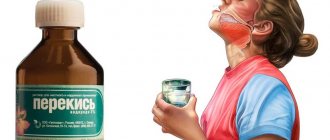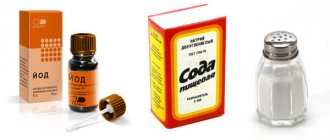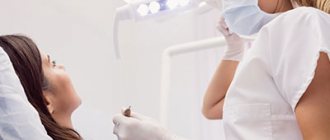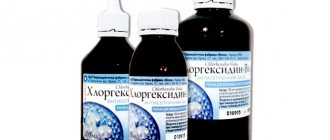What is Chlorhexidine used for?
An aqueous solution is prescribed to be taken in the following cases:
- cervical erosion;
- for the prevention of syphilis, genital herpes and other vaginal diseases;
- disinfection of dentures, disinfection of wounds;
- various diseases of the oral cavity.
An alcohol solution is used to treat hands and medical devices before surgery. The solution is also used to treat the working surface of medical equipment.
Vaginal suppositories are effective for the following conditions:
- in order to prevent infections that can be transmitted as a result of unprotected sexual intercourse;
- bacterial vaginosis;
- prevention of inflammation and infections before surgery, childbirth or abortion.
Composition and release form
Chlorhexidine can be used externally, as a gargle, for douching, or as a vaginal suppository. It interacts well with the skin and mucous membranes without being absorbed into the gastrointestinal tract. The drug destroys fungi, viral infections, gram-positive and negative bacteria (including yeast, dermatophytes and round bacteria), and representatives of the coccal flora.
The main active ingredient of the drug is bigluconate (16 or 20%). The composition of vaginal suppositories additionally includes macrogol. Forms of release of the drug:
- gel;
- solution;
- pills;
- candles;
- ointment;
- spray and aerosol;
- patch.
How to use Chlorhexidine in gynecology
The product is actively used to prevent sexually transmitted diseases. No later than 2 hours after unprotected intercourse, you need to take the solution. Men will need to insert 2 ml into the urinary canal, and women will need to insert 2 ml into the urinary canal and another 5-7 ml into the vagina. It is recommended to wipe the skin around the genitals with the solution. The instructions say that after using the drug you need to wait 2 hours before urinating. Otherwise, the effect of use will be less.
For preventive purposes, vaginal suppositories can be used.
Before using the product for thrush and other gynecological pathologies, you should consult a specialist in advance.
Composition of Chlorhexidine
The composition of the drug is 0.05% solution
Chlorhexidine bigluconate includes 0.5 mg
of chlorhexidine bigluconate
, additional substances.
The composition of the drug is 20% solution
Chlorhexidine Bigluconate includes 0.2 g of active substance, additional substances.
Release form
INN: Chlorhexidine
The form of release of the product is as follows. The drug is available in the form of a 0.05% solution for external use. In a polymer bottle with a nozzle, as well as in glass bottles of 100 ml, 1 bottle in a cardboard package.
A 20% solution of the drug is sold in polymer bottles with a cap, 100 ml, 500 ml.
Suppositories and gel are also produced (it contains lidocaine
), cream, ointment, spray with a similar active ingredient.
pharmachologic effect
An aqueous solution of Chlorhexidine Bigluconate has a local antiseptic effect, predominantly bactericidal. The product is a dichlorine-containing biguanide
. It affects the body by changing the properties of the cell membrane of microorganisms. The cations that are formed due to the dissociation of chlorhexidine salts react with the bacterial membranes, which have a negative charge. The effect of the drug promotes the destruction of the cytoplasmic membrane of the bacterium. Its balance is disrupted, and the bacterium eventually dies.
Chlorhexidine Bigluconate solution 0.05%, gluconate 20% effectively destroys a number of strains of microorganisms. This is Neisseria gonorrhoeae
,
Trichomonas vaginalis
,
Bacteroides fragilis
,
Chlamidia spp
.,
Gardnerella vaginalis
,
Treponema pallidum
.
The drug is also active against Ureaplasma spp
., and also has a moderate active effect against individual strains of
Proteus spp.
and
Pseudomonas spp
.
Viruses demonstrate resistance to the drug (with the exception of the herpes
), fungal spores.
If a rinse with Chlorhexidinum is used to wash hands, or the skin is treated with the drug, Chlorhexidine Bigluconate has a long-term antibacterial effect. Therefore, the drug can be used to treat the surgeon’s hands and the surgical field.
The product retains its antimicrobial activity in the presence of pus, blood, etc., but a decrease in its effectiveness is noted.
Pharmacodynamics and pharmacokinetics
When applied topically, Chlorhexidine is not absorbed into the bloodstream and has no systemic effect.
Indications for use
What the antiseptic is used for can be found in the detailed instructions for the drug. It is widely used to treat diseases that are caused by microorganisms sensitive to the influence of Chlorhexidine, and for their prevention.
The medicine is used to treat certain diseases depending on the concentration of the solution.
A solution of 0.05%, 0.1% and 0.2% is widely used to prevent infectious diseases after surgical interventions. The use of such solutions in dentistry is practiced in order to process dentures. Dentists determine how to use Chlorhexidine in dentistry during various procedures, and also use it for stomatitis.
,
periodontitis
for rinsing gums.
Skin treatment is practiced in urology (if penetration into the urethra, etc.), surgery, and gynecology before and after surgery to prevent infection. The use of the product in gynecology is practiced for the purpose of disinfecting mucous membranes and skin before carrying out a series of manipulations. How to use the solution depends on the type of procedure or manipulation.
In gynecology, Chlorhexidine is also used for thrush. To get rid of thrush, a woman is recommended to douche according to a special scheme.
Chlorhexidine is used in the treatment of many dermatological diseases of both bacterial and fungal origin. The use of the drug is also indicated in the presence of purulent wounds, diseases of the mucous membranes provoked by microorganisms sensitive to the active substance of the drug.
What Chlorhexidine is is known to those who have been seriously injured. The product is often used to treat wounds and damaged skin to prevent infection. What it is, and whether it is worth using the product in a particular case, is determined by the doctor.
Chlorhexidine Bigluconate solution is used to prevent sexually transmitted diseases - genital herpes
,
chlamydia
,
trichomoniasis
,
syphilis
,
gonorrhea
.
Chlorhexidine Bigluconate solution 0.5%
used to treat damage to mucous membranes and skin, as well as for the treatment of medical instruments (the solution temperature should be 70 degrees Celsius).
Chlorhexidine Bigluconate solution 1%
used to prevent infection of burns and wounds, for disinfection before operations, as well as for treating instruments and devices that cannot be subjected to heat treatment.
Chlorhexidine Bigluconate solution 5% and 20%
used in the preparation of solutions based on water, glycerin or alcohol.
Contraindications
The following contraindications to the use of this product are noted:
· High sensitivity to the components of the product.
· Not used to treat patients suffering from dermatitis
.
· Do not use at the same time with other antiseptics (this is hydrogen peroxide
and etc.).
· It is not advisable to use it for disinfection of the surgical field before surgery or after interventions on the central nervous system and auditory canal.
· Not used in ophthalmology (the answer to the question whether it is possible to wash the eyes with this product is negative, since in ophthalmology only a specially prepared solution is used).
· For the treatment of children, use with caution.
Side effects
When using Chlorhexidine Bigluconate during treatment, the following side effects were observed in some patients:
· dry skin;
· itchy skin
;
· appearance of a rash;
· dermatitis
;
· photosensitivity.
With prolonged use of mouth rinses and mouthwashes, taste sensations may change and tartar
, there is a change in the color of the teeth.
Instructions for use Chlorhexidine Bigluconate (Method and dosage)
The instructions for Chlorhexidine stipulate that aqueous and alcoholic solutions of Chlorhexidine are used for the local treatment of infectious diseases.
Instructions for use of Chlorhexidine Bigluconate for the prevention of sexually transmitted diseases are as follows. A 0.05% solution is used no more than two hours after unprotected sexual intercourse. For men, 2-3 ml of the product is injected into the urinary canal, for women, 1-2 ml is injected into the urinary canal and another 5-10 ml into the vagina (like douching in gynecology). It is also advisable to treat the skin near the genitals with the solution. The instructions on how to use the drug in this case contain a warning that urination should be done no earlier than 2 hours after using the drug. Otherwise, the effectiveness of the action decreases.
For prevention in this case, suppositories with Chlorhexidine Bigluconate can also be used.
How to do Chlorhexidine douching for thrush
and other gynecological diseases, and whether it is possible to douche when certain symptoms appear, you should definitely check with your gynecologist first. For douching, a ready-made solution of 0.05% is used, which does not require additional dilution. Before douching, you need to lie down horizontally and, after squeezing a few drops of the product from the bottle into the vagina, lie down for a few minutes. If allergic reactions develop, such procedures should not be performed.
The method of using Chlorhexidine for inflammatory diseases of the urinary tract is as follows: 2-3 ml of 0.05% is injected into the urinary canal once or twice a day. The course of treatment lasts 10 days. This method of application is practiced in men and women.
To treat burns, wounds and other skin injuries, a solution of the drug 0.05%, 0.02% or 0.5% is used. It is used for irrigation or applications. The application is left for a period of 1 to 3 minutes. A spray with a similar active ingredient can also be used.
If it is necessary to disinfect the skin before surgery, use a 20% solution of Chlorhexidine digluconate, which is diluted with 70% ethyl alcohol (1 part of a 20% solution of Chlorhexidine digluconate and 40 parts of 70% alcohol). The surgical field is treated twice with an interval of 2 minutes.
In ENT practice, Chlorhexidine is used for sore throat
,
pharyngitis
,
tonsillitis
. If you have a sore throat, you should gargle with a solution of 0.2% or 0.5%.
Before using Chlorhexidine gargle
, it is recommended to rinse your mouth thoroughly with warm water. Next, gargling for a sore throat is carried out as follows: you should take 10–15 ml (about a tablespoon) of the solution, which can be used to gargle for about 30 seconds. You can repeat these steps one more time. After rinsing, it is advisable not to take food or liquid for 1 hour. The doctor will tell you how to gargle with Chlorhexidine, as well as how many times a day you need to perform this procedure for the throat, taking into account the patient’s individual symptoms. You should also ask the specialist whether it is possible to gargle with Chlorhexidine if the patient notices side effects.
It should be noted that if rinsing your mouth with Chlorhexidine causes a burning sensation, then most likely the solution is too concentrated. The highest permissible concentration is no more than 0.5%. You must first study the instructions on how to dilute the medicine for mouth rinsing. After teeth extraction, rinse your mouth three times a day for 1 minute. Is it possible to rinse your mouth more often and how to rinse your mouth if complications are noted after tooth extraction, you need to find out from a specialist.
Chlorhexidine solution should not be swallowed while rinsing; if the solution accidentally gets into the stomach, you need to drink activated carbon tablets (1 tablet per 10 kg of person’s weight).
Nasal rinsing for sinusitis
This drug should not be practiced on its own. Whether it is possible to rinse the nose is determined solely by the doctor. A solution taken into the nose can enter the cavity of the inner ear or onto the lining of the brain, which is fraught with the development of serious complications.
Overdose
According to the instructions, an overdose of the drug is impossible. If the drug is swallowed, gastric lavage
, use of
activated carbon
, symptomatic treatment.
Interaction
If the pH of the medium exceeds 8, a precipitate forms. If hard water was used when preparing the solution, its bactericidal effect is reduced.
Does not combine with anionic compounds, in particular soap.
Does not mix with chlorides
,
carbonates
,
phosphates
,
sulfates, borates
,
citrates
.
of neomycin increases
,
kanamycin
,
chloramphenicol
,
cephalosporin
.
Ethyl alcohol enhances the bactericidal effect.
Terms of sale
Sold in pharmacies without a doctor's prescription.
Storage conditions
The drug should be stored in a dark, dry place, storage temperature - from 1 to 25 degrees Celsius.
Best before date
Solution 0.05%
can be stored for 2 years.
Solution 20%
can be stored for 3 years.
Prepared solutions can be stored for 1 week.
special instructions
The solution remains active in the presence of blood and organic substances. Contact of the drug with the eyes, membranes of the brain and the auditory nerve should be prevented.
In people with open TBI
, damaged spinal cord,
perforation of the eardrum,
it is necessary to avoid getting the product on the surface of the brain, meninges, and also into the tympanic cavity.
If the drug gets into your eyes, rinse them immediately.
It is not recommended to mix with other detergents and disinfectants.
If clothing has been in contact with the product, do not expose it to hypochlorites.
, producing active chlorine.
Analogs
Analogs of Chlorhexidine Bigluconate are drugs that contain a similar active substance. Analogues are available in the form of different dosage forms - gels, solutions, ointments, suppositories. This is Hexicon
,
Hexicon D
(for children),
Hibiscrub
,
Amident
, etc.
Other antiseptics, such as iodine or hydrogen peroxide, can also be used.
Which is better: Chlorhexidine or Miramistin
?
Many people are convinced that Miramistin
and Chlorhexidine are the same thing. In fact, these drugs do belong to the same class of antiseptics. What is the difference between Chlorhexidine and Miramistin is in the active substances contained in the preparations. Miramistin is not a complete analogue of Chlorhexidine. It has a pronounced antifungal and antiviral effect. Therefore, there are some differences in the indications for use of this drug. Miramistin is not contraindicated for people suffering from dermatitis.
Synonyms
Hexicon.
For children
For the treatment of children, the drug is used with caution and only after a doctor’s prescription.
During pregnancy and lactation
Chlorhexidine can be used topically during pregnancy and breastfeeding. However, despite the fact that pregnancy is not a contraindication to the use of the drug, prolonged use of the solution is not recommended.
Gargling during pregnancy is possible only under the supervision of a doctor.
Contraindications and adverse reactions
Taking the drug is contraindicated in the following cases:
- increased susceptibility to the components included in the composition;
- patients with dermatitis;
- simultaneous use with other antiseptics, for example, hydrogen peroxide;
- in ophthalmology for washing the eyes.
It is better to refrain from using the product to disinfect the surgical field before or after surgery on the central nervous system and auditory canal.
In pediatrics, the drug is used with great caution.
Some patients may experience undesirable reactions such as:
- dry skin;
- allergic skin rashes;
- itching of the skin;
- light sensitivity.
With prolonged use of the product in dentistry, changes in taste may occur, tartar may appear, or teeth may become stained.
Can pregnant women take it?
During pregnancy, Chlorhexidine is only suitable for external use.
Therefore, a solution for rinsing, irrigation, and washing the ENT organs becomes especially relevant during the period of bearing a child. Although the drug is considered safe for mother and child, it can only be used after consulting a doctor. Some sources indicate that such a drug can also be used for douching in pregnant women in the case of various pathologies of the genital organs. But the douching procedure itself is contraindicated during gestation or should be performed only in the manipulation room by a medical institution employee.
In case of urgent need, it can be replaced by using intravaginal Chlorhexidine suppositories or self-made tampons soaked in a solution of this drug.
In 1st trimester
Perhaps the most crucial period in pregnancy is the 1st trimester , since it is at this time that the baby and the protective placenta are formed, and all vital organs and systems are formed.
Therefore, despite the safety of the drug, it should be used only after consultation with the doctor.
In the 2nd trimester
During this period, the already formed embryo begins to develop, it is already reliably protected by the placenta, so any external influence is not so scary for it. But still, in order to avoid possible risks, it is better to consult a doctor about the advisability of using the drug.
In the later stages
The medication has no effect on the uterus and cannot provoke premature birth.
On the contrary, the drug is actively used in the prenatal period for the sanitation of the birth canal and after (for the treatment of cracks and tears in the perineum).
What side effects may occur?
Possible side effects that may occur after using Chlorhexidine include the following:
- skin rash;
- specific temporary color of the tongue and teeth;
- distortion of taste, which is usually due to the bitterness of the rinse solution;
- itching in the vagina;
- burning sensation in the throat.
However, all these side effects are quite rare and are usually associated with long-term use of the drug. Possible associated symptoms:
- sleep disturbance;
- dry mouth;
- sticky palm effect;
- unpleasant taste;
- headache.
Dental diagnostics during pregnancy
If there is a need to remove a tooth or the patient has been diagnosed with pulpitis, an image cannot be avoided. However, traditional X-rays are contraindicated for pregnant women. After all, the fetus is sensitive to radiation. If an x-ray is necessary, it is best to postpone such a diagnosis to the 2nd trimester. In this case, it is necessary to cover the patient’s abdomen and pelvic area with a lead belt. It minimizes exposure to radiation.
The safest method of dental diagnosis for pregnant women is digital radiovisiography. This technique allows you to reduce the radiation load by 90% compared to conventional x-rays.
In what cases is it prescribed for pregnant women?
Chlorhexidine is allowed during pregnancy even in the early stages. The drug is not absorbed into the general bloodstream, as a result of which it does not have a negative effect on the fetus or the health of the expectant mother. Despite the wide scope of application, the following indications are distinguished for which the drug is prescribed during pregnancy:
- thrush;
- inflammatory process affecting the vulva and vagina;
- sexually transmitted infectious diseases;
- diseases that cause a sharp increase in pathogenic microflora.
Suppositories or douching with a solution are prescribed before childbirth so that the baby does not become infected after passing through the birth canal. Gargling is also not contraindicated and is effective for stomatitis, inflammation of the nasopharynx of various origins, and ENT diseases.
Overdose and interaction with other drugs
Until now, cases of Chlorhexidine overdose have not been reported in medical practice. However, it is always necessary to adhere to the dosages specified in the instructions or selected by a specialist. Also, you should not use the drug for longer than the prescribed course.
Regarding the simultaneous use of Chlorhexidine with other medications, it is prohibited to use the drug with:
- iodine-containing products;
- products containing saponins, sodium lauryl sulfate, sulfonic acid.
Nasal rinsing schedule
In what cases and with what frequency should pregnant women wash their nose?
| Disease | Flushing schedule |
| As a preventive measure | 2-3 times a week |
| Inflammatory disease | 4 times a day for one to two weeks |
| For chronic diseases of the upper respiratory tract | Constantly carrying out the procedure 4-5 times a day every day |
A pregnant woman who cares about her well-being and the health of her unborn baby needs to know that rinsing the nasal cavity is an effective measure for the treatment and prevention of many diseases. This procedure does not threaten the health and development of the child, and effectively helps the expectant mother get rid of nasal congestion and runny nose. Sialor® Aqua sea water copes well with these tasks, and the ergonomic packaging in the form of buffets makes its use simple and convenient, wherever you are.
pharmachologic effect
Chlorhexidine is characterized by its versatility. By destroying the entire cell structure of pathogenic microorganisms, it leads to the rapid death of bacteria. The drug is stable, after treatment of the skin it remains on its top layer, continuing to have a bactericidal effect. In gynecology, in the form of vaginal suppositories, the product is effective for the treatment of the following diseases:
- syphilis and gonorrhea;
- trichomoniasis;
- thrush;
- chlamydia;
- gardnerellosis;
- ureaplasmosis.
Rinse your mouth with the solution and rinse your sinuses. As an antiseptic, it can be used to disinfect mucous membranes upon penetration of infectious microflora. Often the drug is prescribed as part of complex therapy, when treatment with antibacterial drugs is contraindicated, and for the purpose of prevention.
Are there any contraindications?
Despite its universal nature, the absence of negative effects on the fetus and side effects, Chlorhexidine, in accordance with the instructions for use, also has contraindications:
- inflammation of the skin (for example, dermatitis) - in this case, treatment with the drug is impossible;
- hypersensitivity to components - a similar condition is often observed in pregnant women;
- simultaneous use with other antiseptics or medications that contain iodine;
- too young;
- period of menstruation.
Treatment of the conjunctiva with Chlorhexidine solution is prohibited. It should be remembered that self-medication, especially during pregnancy, is prohibited.
Nuances of dental treatment for pregnant women
The period of gestation in itself is not a contraindication to dental treatment. But when visiting a doctor, he must be warned about pregnancy, and also tell the due date. In this case, the following features arise during dental treatment:
- Bleaching is not allowed.
- Local anesthesia is required.
- It is possible to treat caries, pulpitis, periodontitis and gum inflammation.
- Under no circumstances should general anesthesia be used.
- Chemical and photo-curing materials can be used for filling. Polymer lamps do not harm the child.
Advice to expectant mothers - try to treat your teeth and gums before pregnancy or between the 3rd and 6th months of pregnancy, and also review your diet. If you have carious cavities, you will pass on a bouquet of microbes to your unborn child, and the destruction of your own teeth will accelerate several times.
Medvedeva Tatyana Dmitrievna, Pediatric dentist, dental therapist, work experience 19 years
The benefits of sea water for the treatment and prevention of runny nose
Sea water has a similar composition to our body fluids. Rinsing the nose with solutions based on sea salt does not cause any discomfort. Sea water contains a whole range of useful microelements: sodium, magnesium, calcium, potassium and others. Due to its rich natural composition, this solution has a number of advantages:
- physical cleaning of the nasal surface from bacteria, viruses and allergens (minimizing allergies);
- natural antiseptic – the negative manifestation of the inflammatory process is reduced, the spread of infection is prevented;
- stimulation of blood circulation - blood flow optimizes the functioning of cells that provide a protective function;
- anti-inflammatory effect;
- rapid healing of damaged mucous membrane;
- strengthening local immunity.
A saline solution for rinsing the nose for pregnant women is the main effective way to combat colds and runny nose at home.











